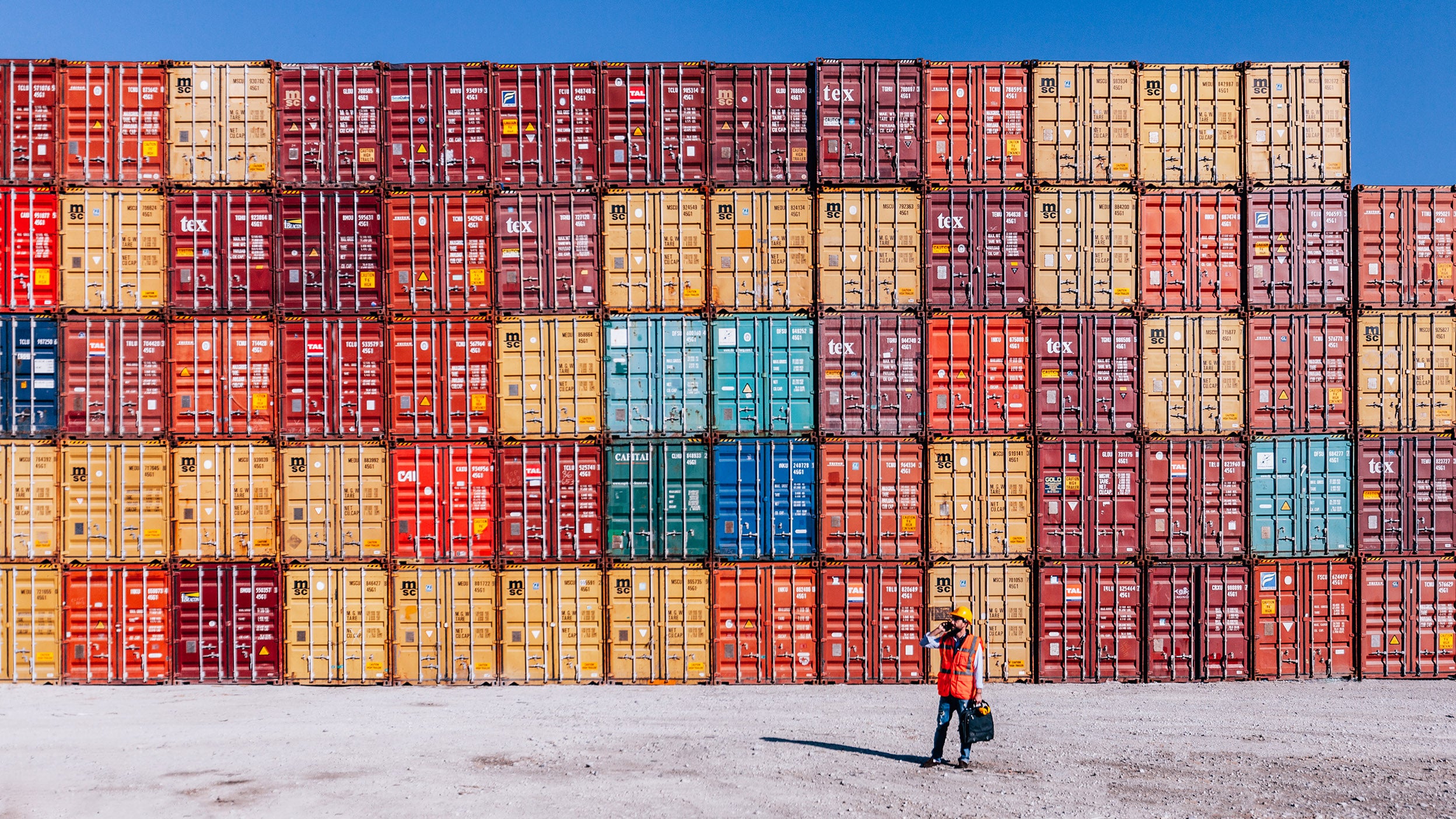
Markets and Economy Above the Noise: Policy uncertainty persists
The challenges of the current investment environment are well documented, so maybe it’s more interesting to talk about what could go right.

US President Donald Trump unveiled sweeping new tariffs in his “Liberation Day” announcement on April 2.
We anticipate significant volatility and downward pressure on risk assets in the near term.
Canada and Europe look to increase spending, which would be expected to benefit their economy and industries.
US President Donald Trump unveiled sweeping new tariffs in his “Liberation Day” announcement on April 2, adding to the list of tariffs that were already announced in the first several weeks of his second term. The April 2 tariffs came in two parts1:
Responses started shortly after Trump’s announcement. European Commission President Ursula von der Leyen said “We are already finalizing the first package of countermeasures in response to tariffs on steel, and we are now preparing for further countermeasures to protect our interests and our businesses if negotiations fail.”3
To help put the escalating trade wars into perspective, we asked a variety of Invesco’s global experts for their views. This is an evolving story, and we will continue to update with more perspectives.
The risk of recession increases every day that these high tariffs are in force. We anticipate significant volatility and downward pressure on risk assets in the near term. The risk of stagflation in the US has also increased.
The good news is that there are staggered implementation dates, which supports the theory that these tariffs are being used as a bargaining tool and are not expected to be long term in nature. And some countries have indicated they will reduce the tariffs they apply to US imports.
In the short term, there will likely be significant downward pressure on US stocks and stocks of countries with high tariffs. We expect the US dollar to weaken as growth slows and demand for dollar-denominated assets declines with an anticipated reduction in the trade deficit. We anticipate gold will continue to rise on geopolitical and economic policy uncertainty. We think European equities and Chinese equities could perform well, assuming fiscal stimulus will help support economic growth.
For those with a short time horizon, we believe it would be prudent to be risk off. Those with a longer time horizon may consider taking advantage of sell-offs in order to increase their exposure to risk assets, taking cash off the sidelines, and remaining well diversified.
The hopes heading into “Liberation Day” were twofold: first, that the tariffs wouldn’t be as high as feared, and second, that clarity would be restored to markets. Unfortunately, neither hope came true. The uncertainty for markets persists as we await to learn which countries will pursue retaliatory tariffs on the US and which will seek to make concessions to the Trump administration in exchange for lower tariffs.
Tariffs lead to less optimal economic outcomes, plain and simple. While we can debate whether they are worth the hit to corporate profitability and the increase in prices of consumer goods, someone ultimately pays for them. I anticipate the US economy to further slow, and the longer the tariffs are in place, the greater the risk to the US business cycle. Compounding the problem, rising prices may prevent the US Federal Reserve from responding aggressively to counteract the economic weakness. It’s difficult to make a compelling case for US equities here unless a meaningful shift in trade and monetary policy emerges.
US tariffs on Canadian exports (autos, steel, lumber, etc.) will have a profound impact on the Canadian economy. It will take time to establish new trading partners, and for many goods (such as oil), the US is destined to remain Canada’s primary export market. Some industries will be hit harder than others, and we anticipate the pain will reverberate through many communities. For example, the city of Windsor (which sits across the river from Detroit) could be devasted by tariffs and/or any wind-down in Canadian auto production. Canada will need to focus on encouraging new business investment, improving productivity, fostering innovation, and broadening trade and security alliances. There is now a newfound sense of urgency in Canada to develop its vast natural resources, invest in infrastructure, and increase domestic military spending in order support the economy for years to come. I expect these expenditures to be positive for the Canadian industry and may present interesting long-term growth opportunities for select Canadian businesses.
In the wake of Trump’s tariff announcement and the global response, policy uncertainty is likely to remain present, and volatility is expected to be elevated. The aggressive implementation of tariffs also puts expectations for accelerating profit growth in 2025 at risk and could push out a profit recovery.
In my view, all this reinforces the case for owning defensive factors such as low volatility, quality, and yield. Furthermore, the tariff picture could change quickly, so the potential to participate in market strength while mitigating or dampening downside risk should be attractive, in my opinion. The tariff saga is a reminder that factors can be used both tactically and strategically to help create a more durable portfolio.
What do Trump’s tariff announcements mean for Europe? In terms of gross domestic product (GDP), could the 20% tariff increases for Europe largely offset the positive impact expected from Germany’s recent spending announcements in 2025? To us, that appears a bit on the aggressive side, but clearly there will be a sizeable impact this year if there’s no renegotiation. That said, it was partially because of the US becoming more adversarial in the first place that Europe started to put in place additional spending plans — the ReArm defence plan and German Infrastructure/Defence plan.
Also, don’t forget that this is a step change in tariff levels, meaning that it is largely a one-year effect. Hence, we expect a short-term headwind, but as demand/supply adjust to higher prices, then it should have a muted impact thereafter. A speedy resolution is therefore key.
For Europe, this only highlights the importance of becoming more self-sufficient. The severity of the tariff increases is only likely to reinforce this message. Thankfully Europe is rising to the challenge. This means we’re confident that the medium to long-term outlook for GDP is a good deal better than it’s been since the Global Financial Crisis. One of the key problems in the last decade or so has been the lack of government investment, particularly in Germany. But we expect decent growth to continue in Southern Europe, and — putting the tariff impact to one side — we expect Germany’s fiscal plans could add 1%-2% to the rate of GDP growth in due course. So, to us it looks like at least two-thirds of Europe is well placed to grow in the medium term.
The reciprocal tariffs recently implemented by the Trump administration are impactful for many commodities from all three sectors: energy, metals, and agriculture. Although crude oil and gold are not subject to reciprocal tariffs, these markets are still feeling pressure as concerns around the global economy and demand for raw materials escalate.
These tariffs were more aggressive than analysts expected and are viewed as ceilings which might be lowered as negotiation between Trump and his international peers increases. Commodities tend to have an inverse relationship to the US dollar, but we have seen weakness in both. China is the biggest buyer of commodities, and the high tariffs imposed on this country hurts this sector. There is also concern around the grains market in terms of possible retaliation, as China may continue to lower their purchases of US grains like soybeans and corn. But it’s important to remember that one big weather event could dwarf the tariff impacts on grains.
Industrial metals are also feeling pressure even though copper tariffs are still part of a Commerce Department investigation and likely to start at the end of April, at the earliest. US copper recently hit an all-time high with many market participants sending copper from the London Metals Exchange (LME) to the US to pre-position for this expected tariff.
Another factor to consider is the risk of stagflation as the tariffs may lead to higher inflation and slower economic growth. Gold and broad-based commodities tend to hedge stagflation.
As we have underscored in the past, a big part of the US growth story has been underpinned by the spending of the top category of US consumers who have enjoyed balance sheet wealth on the back of rising asset prices. Therefore, I expect a correction in asset prices (i.e., the “exceptional” US stock market) that accompanies a contraction in US profits as corporations take a margin hit as a result of tariffs, to create significant secondary feedback risks to US growth. This may provide an opportunity for investors in non-US assets.
From a market share perspective, we are very concerned about capital intensive industries in Northeast Asia (though semiconductors seem to be excluded for now). This concern goes beyond tariffs to underlying autarkic pressures — the US and China, regardless of compelling logic, are motivated to reshore significant capacity of semiconductors, autos, etc. This is not good for Taiwan, Korea, or Japan. Thus far, other critical sectors to the US have been excluded from increased tariffs, including pharmaceuticals and some metals.
The ultimate impact on emerging markets comes down to two important factors, in my view. First, there is the potential for considerable further depreciation of the US dollar. Weak global demand and a US recession would help no one (including emerging markets). But emerging markets (and international equities) would likely relatively outperform in a weaker US dollar environment given more compelling valuations and the move of capital away from the US with the end of exceptionalism. And this may only be the beginning.
Second, I believe China remains inexpensive and under-owned, featuring high-quality growth companies with globally relevant innovation. Will China now be compelled to reflate domestic demand with significantly larger stimulus? This seems intuitively likely, but not certain. If Beijing does make that decision, I believe Chinese stocks could outperform.
US trade policy continues to be a risk for global markets. The April 2 announcement of reciprocal tariffs by the US administration did not impact Mexico and Canada as much as others given the continuation of USMCA (United States-Mexico-Canada Agreement) exemptions. This separation indicates a willingness to work/negotiate separately with both countries as the US administration’s goals for both countries are more than just the trade deficit. Immigration, national security, and drug policies need to be addressed as well.
The other observation is the direction of travel on China. We see it more as a confirmation of the strong signal we were expecting rather than a change in policy, and should view it as the classic goal of tariffs. However, ASEAN countries (the Association of Southeast Asian Nations) were hit more aggressively than previously thought, as these countries would be hit by, not just lower, but also more sectoral-specific tariffs. I expect the damage from the indirect effects of slowing demand from Asia’s trading partners to be a further hit in the future, as trade slows.
While ultimate tariff outcomes remain unpredictable, they remain the biggest overhang for global growth and US Federal Reserve policy. Although we do have some clarity now on the starting point of negotiations, we continue to believe that the dispersion of returns among emerging market countries may be very wide, as individual countries may have less room to counter certain trade policies or may approach the tradeoff between growth and inflation versus currency depreciation differently.
Finally, trade and geopolitical uncertainty is forcing other regions to try to reinvigorate their domestic economies. Both China and Europe are more and more incentivized to use fiscal policy, which may encourage other emerging markets to do the same. That, in the end, could narrow down the difference between the US and the rest of the world significantly, and could change the trajectory of the US dollar strength we have experienced for over a decade.
Coming into this year, we expected volatility as the new administration established their policies, and we are getting exactly that. However, we continue to take a long-term approach and tend not to react to short-term noise. In the past, municipals have been seen as a refuge for investors during periods of turmoil, and we think that’s still true today.
Investment grade and high yield municipal bonds can help diversify portfolios containing domestic equities, US corporate bonds, and US Treasuries. We believe this diversification is especially important during periods of uncertainty. In our experience, diversification has the potential to increase opportunities for growth and to help mitigate portfolio risk.
We remain constructive on both duration and credit in the municipal bond market and believe investors could consider taking advantage of these periods of volatility to leg back into the municipal market if they haven't already.
Source: Wall Street Journal, “Tariff News, April 2, 2025: Trump Unveils Sweeping Levies in Stark Shift in Trade Policy,” April 2, 2025
Source: CNBC, “Trump’s tariffs risk a global trade war, as leaders plan next steps,” April 3, 2025
Source: Politico, “EU ‘prepared’ to retaliate against Trump’s 20 percent tariffs,” April 3, 2025

The challenges of the current investment environment are well documented, so maybe it’s more interesting to talk about what could go right.

The global economic outlook is uncertain, yet European, UK, Chinese, and Japanese stocks all rose last week while US stocks fell.

While stock market volatility can be unsettling in times of uncertainty, remembering these things can help you weather the storm.
Important information
NA4377234
Image: serts / Getty
All investing involves risk, including the risk of loss.
Past performance does not guarantee future results.
Investments cannot be made directly in an index.
Diversification does not guarantee a profit or eliminate the risk of loss.
This does not constitute a recommendation of any investment strategy or product for a particular investor. Investors should consult a financial professional before making any investment decisions.
In general, stock values fluctuate, sometimes widely, in response to activities specific to the company as well as general market, economic and political conditions.
The risks of investing in securities of foreign issuers, including emerging market issuers, can include fluctuations in foreign currencies, political and economic instability, and foreign taxation issues.
Investments in companies located or operating in Greater China are subject to the following risks: nationalization, expropriation, or confiscation of property, difficulty in obtaining and/or enforcing judgments, alteration or discontinuation of economic reforms, military conflicts, and China’s dependency on the economies of other Asian countries, many of which are developing countries.
Fluctuations in the price of gold and precious metals may affect the profitability of companies in the gold and precious metals sector. Changes in the political or economic conditions of countries where companies in the gold and precious metals sector are located may have a direct effect on the price of gold and precious metals.
Commodities may subject an investor to greater volatility than traditional securities such as stocks and bonds and can fluctuate significantly based on weather, political, tax, and other regulatory and market developments.
Investments in real estate-related instruments may be affected by economic, legal, or environmental factors that affect property values, rents or occupancies of real estate. Real estate companies, including REITs or similar structures, tend to be small and mid-cap companies and their shares may be more volatile and less liquid.
Alternative products typically hold more non-traditional investments and employ more complex trading strategies, including hedging and leveraging through derivatives, short selling and opportunistic strategies that change with market conditions. Investors considering alternatives should be aware of their unique characteristics and additional risks from the strategies they use. Like all investments, performance will fluctuate. You can lose money.
Fixed income investments are subject to credit risk of the issuer and the effects of changing interest rates. Interest rate risk refers to the risk that bond prices generally fall as interest rates rise and vice versa. An issuer may be unable to meet interest and/or principal payments, thereby causing its instruments to decrease in value and lowering the issuer’s credit rating.
High yield bonds, or junk bonds, involve a greater risk of default or price changes due to changes in the issuer’s credit quality. The values of junk bonds fluctuate more than those of high quality bonds and can decline significantly over short time periods.
Municipal securities are subject to the risk that legislative or economic conditions could affect an issuer’s ability to make payments of principal and/ or interest.
Gross domestic product (GDP) is a broad indicator of a region’s economic activity, measuring the monetary value of all the finished goods and services produced in that region over a specified period of time.
A risk asset is generally described as any financial security or instrument that carries risk and is likely to fluctuate in price.
Risk-off refers to price behavior driven by changes in investor risk tolerance; investors tend toward lower risk investments when they perceive risk as high.
Stagflation is an economic condition marked by a combination of slow economic growth and rising prices.
A trade deficit is an economic measure of international trade in which a country's imports exceed its exports. Therefore, a trade deficit represents an outflow of domestic currency to foreign markets.
Cash flow is the net amount of cash and cash equivalents generated by a business.
Monetary easing refers to the lowering of interest rates and deposit ratios by central banks.
The European Commission is the European Union’s executive arm. It takes decisions on the EU’s political and strategic direction.
ASEAN stands for the Association of Southeast Asian Nations, an intergovernmental organization of Southeast Asian countries.
Duration is a measure of the sensitivity of the price (the value of principal) of a fixed income investment to a change in interest rates. Duration is expressed as a number of years.
The opinions referenced above are those of the author as of April 4, 2025. These comments should not be construed as recommendations, but as an illustration of broader themes. Forward-looking statements are not guarantees of future results. They involve risks, uncertainties and assumptions; there can be no assurance that actual results will not differ materially from expectations.
This link takes you to a site not affiliated with Invesco. The site is for informational purposes only. Invesco does not guarantee nor take any responsibility for any of the content.